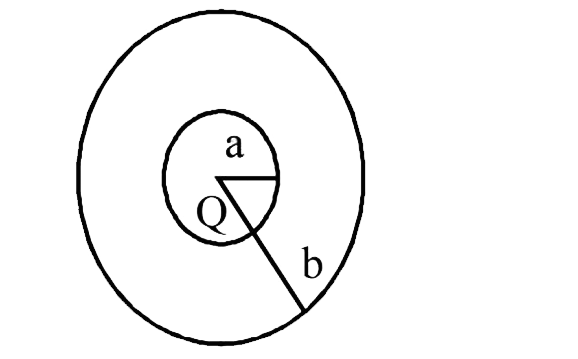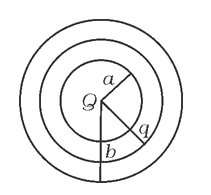The region between two concentric spheres of radii 'a' and 'b', respectively (see figure), have volume charge density ρ=Ar, where A is a constant and r is the distance from the centre. At the centre of the spheres is a point charge Q. The value of A such that the electric field in the region between the spheres will be constant, is:

Q2πa2
Q2π(b2−a2)
2Qπ(a2−b2)
2Qπa2
The correct Answer is:A
Draw, Gaussian surface at distance r from centre,
Using Gauss law Q+∫raAr4πe2dre0=E4πr2
E4πe0r2=Q+A4π[r2−a22)
E=14πe0[Qr2+A2p(r2+a2r2))],E=14πe0[Qr2+A2π−A2πa2r2))
For E to be constant (ie independent of r)
Qr2−2Aπa2r2=0.......(i)∴E=14πe0×A×2π.........(ii)
At the centre of the spheres is a point charge Q. The value of A such that the electric field in the region between the spheres will be constant is (using equation (i)] :
As Q=2πAa2i.e.,A=Q2πa2

Similar Questions
A system consists of a uniformly charged sphere of radius R and a surrounding by a medium with volume charge density ρ=ar, where α is a positive constant and r is the distance from the centre of the sphere. If NαR2 is the charge on the sphere when the electric field intensity outside the sphere is independent of r. What is the value of N ?
View SolutionA solid sphere of radius R has a charge Q distributed in its volume with a charge density ρ=kra, where k and a are constants and r is the distance from its centre. If the electric field at r=R2 is 18 times that r=R, find the value of a.
View Solution
Knowledge Check
A solid sphere of radius R has a volume charge density ρ=ρ0r2 (where ρ0 is a constant ans r is the distance from centre). At a distance x from its centre (for x<R), the electric field is directly proportional to :
A1/x2B1/xCx3Dx2An insulating solid sphere of the radius R is charged in a non - uniform manner such that the volume charge density ρ=Ar, where A is a positive constant and r is the distance from the centre. The potential difference between the centre and surface of the sphere is
AAR8ε0BAR4ε0CARε0DAR2ε0A system consists of a uniformly charged sphere of radius R and a surrounding medium filled by a charge with the volume density ρ=αr , where α is a positive constant and r is the distance from the centre of the sphere. Find the charge of the sphere for which the electric field intensity E outside the sphere is independent of R.
Aα2ε0B2αε0C2παR2DNone of these
A solid sphere of radius R is charged with volume charge density p=Krn , where K and n are constants and r is the distance from its centre. If electric field inside the sphere at distance r is proportional to r4 ,then find the value of n.
View SolutionA solid sphere of radius R has a mass distributed in its volume of mass density ρ=ρ0 r, where ρ0 is constant and r is distance from centre. Then moment of inertia about its diameter is
View SolutionA solid non conducting sphere of radius R has a non-uniform charge distribution of volume charge density, ρ=ρ0rR, where ρ0 is a constant and r is the distance from the centre of the sphere. Show that : (i) the total charge on the sphere is Q=πρ0R3 (ii) the electric field inside the sphere has a magnitude given by, E=KQr2R4
View SolutionA system consits of a uniformly charged sphere of radius R and a surrounding medium filled by a charge with the volume density ρ=αr, where α is a positive constant and r is the distance from the centre of the sphere. Find the charge of the sphere for which the electric field intensity E outside the sphere is independent of R.
View SolutionA solid sphere of radius R has a charge Q distributed in its volume with a charge density ρ=kra, where k and a are constants and r is the distance from its centre. If the electric field at r=R2 is 18 times that r=R, find the value of a.
View Solution
